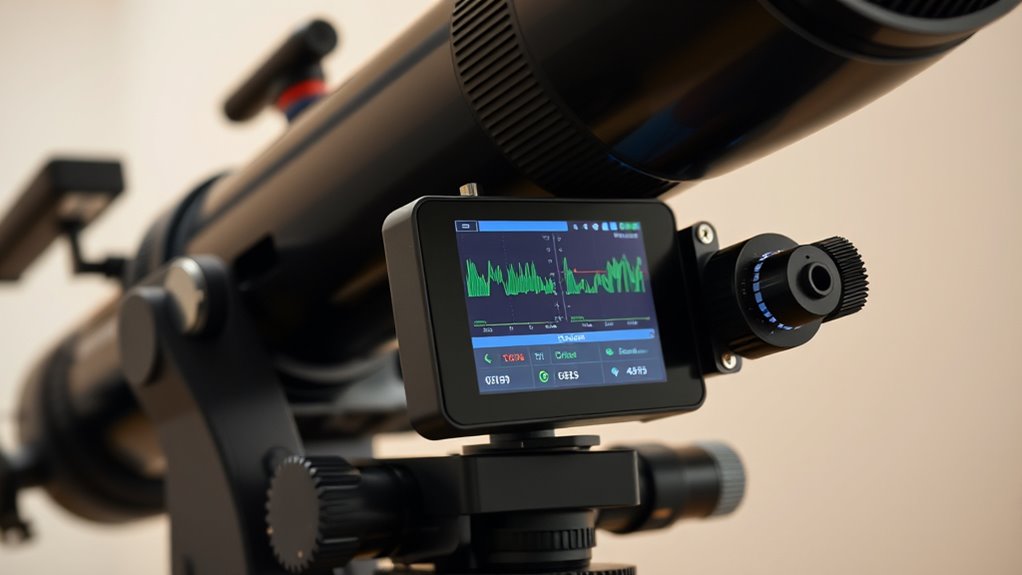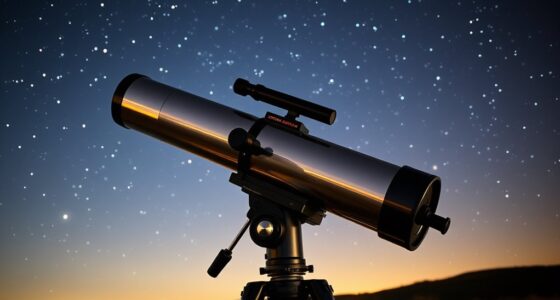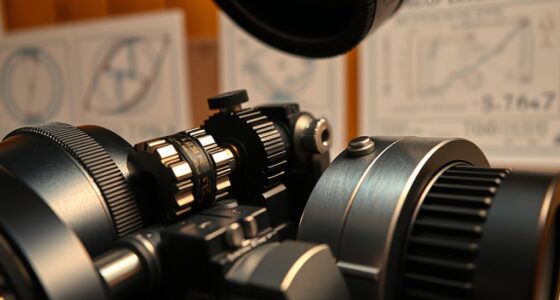To monitor tracking errors using mount diagnostics tools, you should regularly analyze the data they provide. These tools detect misalignments, environmental impacts, and firmware issues that may cause tracking inaccuracies. By reviewing their diagnostics, you can identify problems early and make precise adjustments, like recalibrating your mount or updating firmware. Staying proactive with these checks helps guarantee your imaging stays clear and accurate. Keep going to discover how to optimize your setup even further.
Key Takeaways
- Use diagnostics tools to detect deviations indicating misalignment or tracking inaccuracies.
- Analyze tracking data to identify patterns or sudden errors caused by environmental or setup issues.
- Regularly perform firmware updates through diagnostics tools to improve mount stability and error correction.
- Conduct routine calibration and alignment checks using diagnostic reports to prevent cumulative tracking errors.
- Monitor mount performance over time to proactively identify and address recurring tracking issues before they affect imaging.

Monitoring mount errors is essential to guarantee your telescope operates smoothly and captures clear images. When tracking celestial objects, even minor errors can lead to blurry or elongated images, so keeping a close eye on your mount’s performance is critical. One common cause of tracking errors is alignment issues. If your mount isn’t properly aligned with the night sky, it’ll struggle to follow objects accurately. Ensuring your mount is aligned correctly before each session can dramatically reduce errors. Many mount diagnostics tools can detect misalignments and help you fine-tune your setup. These tools analyze the tracking data and highlight deviations caused by poor alignment, guiding you to make precise adjustments. Proper alignment isn’t a one-time task; environmental factors like temperature changes or slight shifts in your setup can introduce errors over time. Regularly verifying and recalibrating your alignment helps maintain excellent tracking performance.
Another vital aspect is keeping your mount’s firmware updated. Firmware acts as the software backbone of your mount’s control system, ensuring it operates with the latest features and bug fixes. Outdated firmware can cause various issues, including inconsistent tracking and false error signals. Manufacturers often release firmware updates to improve stability, correct known bugs, and enhance compatibility with new accessories or software. Staying current with these updates allows your mount to perform at its best, reducing the likelihood of errors that can compromise your imaging session. Many mount diagnostic tools can also check your firmware version and notify you when updates are available, making maintenance straightforward. Regular firmware updates are a simple yet effective way to prevent many common tracking problems and keep your mount running smoothly.
Monitoring mount errors isn’t just about reacting to problems; it’s about proactively maintaining your equipment. By paying attention to alignment issues and ensuring your firmware is current, you establish a solid foundation for accurate tracking. Diagnostic tools provide invaluable insight into how well your mount is performing, allowing you to address issues before they impact your imaging. When you notice consistent errors, it’s often a sign that your alignment needs refinement or that a firmware update is overdue. Incorporating routine checks using these tools keeps your setup refined and minimizes downtime. Ultimately, staying vigilant about these factors will improve your astrophotography results, helping you capture crisp, clear images of the night sky with confidence.
Frequently Asked Questions
How Can I Prevent Mount Tracking Errors Before They Occur?
To prevent mount tracking errors, start with precise polar alignment using a good polar scope or software. Regularly check and refine your alignment to guarantee accuracy. Enable auto guiding to correct minor tracking issues in real-time, reducing drift during long exposures. Keep your mount’s gears well-lubricated and balanced to minimize mechanical errors. Consistent setup and calibration help maintain accurate tracking, preventing errors before they happen.
What Are the Common Causes of Mount Tracking Errors?
You might think tracking errors are unpredictable, but they often stem from optical misalignment or mechanical instability. If your mount isn’t precisely aligned or if its components aren’t stable, it can cause consistent errors. Regularly check and maintain optical alignment, tighten mechanical parts, and make sure your mount is on a stable surface. Addressing these common causes helps prevent tracking errors and keeps your observations sharp and accurate.
How Often Should I Calibrate My Mount for Optimal Performance?
You should calibrate your mount regularly to maintain ideal tracking precision. Typically, performing mount calibration once every few months is sufficient, but if you notice tracking issues or change locations, recalibrate sooner. Consistent calibration ensures your mount stays accurate, especially during long exposures. Keep an eye on tracking performance, and don’t hesitate to recalibrate whenever needed to keep your astrophotography sharp and precise.
Can Environmental Factors Influence Mount Tracking Accuracy?
Like a knight in shining armor facing a turbulent sea, your mount’s tracking accuracy can be affected by environmental factors. Atmospheric turbulence causes unstable air currents that jitter your telescope, while light pollution obscures celestial details. Both can lead to tracking errors. To maintain precision, consider controlling your environment, such as observing in darker skies and avoiding windy conditions, ensuring your mount performs at its best.
What Troubleshooting Steps Are Recommended for Persistent Mount Errors?
If you experience persistent mount errors, start by checking for alignment issues, ensuring your mount is properly calibrated and balanced. Then, investigate potential software glitches by updating your mount control software and firmware. Restart your system, re-run diagnostics, and verify all connections. If errors persist, consider recalibrating the mount or consulting the manufacturer’s troubleshooting guide to identify specific problems related to hardware or software.
Conclusion
By keeping a close eye on mount diagnostics, you turn troubleshooting into a dance rather than a stumble. When you monitor tracking errors diligently, you’re not just fixing issues—you’re fine-tuning a symphony of precision. Think of it as guiding your telescope with the steady hand of a maestro, ensuring every celestial note hits perfectly. So, embrace these tools—they’re your secret to a flawless night under the stars, transforming frustration into cosmic harmony.








